Fender’s most important gift to the effects cosmos is spring reverb. That legacy, however, tends to obscure other high points in the company’s effects history, which is dotted with a few classics—if not runaway commercial hits.
At appealing prices ranging from $79 to $99, the new Fender Hammertone pedals could easily be huge sellers. But what makes these effects extra attractive is that they don’t have the functional or operational feel of generic entry-level pedals. Most have a strong, even distinctive, personality—at least compared to other inexpensive effects. They each come with extra features and voices that stretch the boundaries of the foundational tones. And if the voices aren’t always the most refined or lush when compared to more expensive analog equivalents or expensive digital units, they are fun and prompt a lot of musical sparks.
With one eye on 1960s and ’70s stylings (Hammerite-style paint, chrome- and candy-colored knobs) and another on concessions to modernity like mini toggles, smart one-screw back-panel access, top-mounted jacks, and smooth, sturdy pots, the Hammertone pedals are nice design pieces. They also seem very well made for the price. I’m usually skeptical about an inexpensive pedal’s ability to hold up over the long haul, but the Hammertone series seem put together right.
Fender Hammertone Pedals Demo | First Look
Hammertone Reverb Review
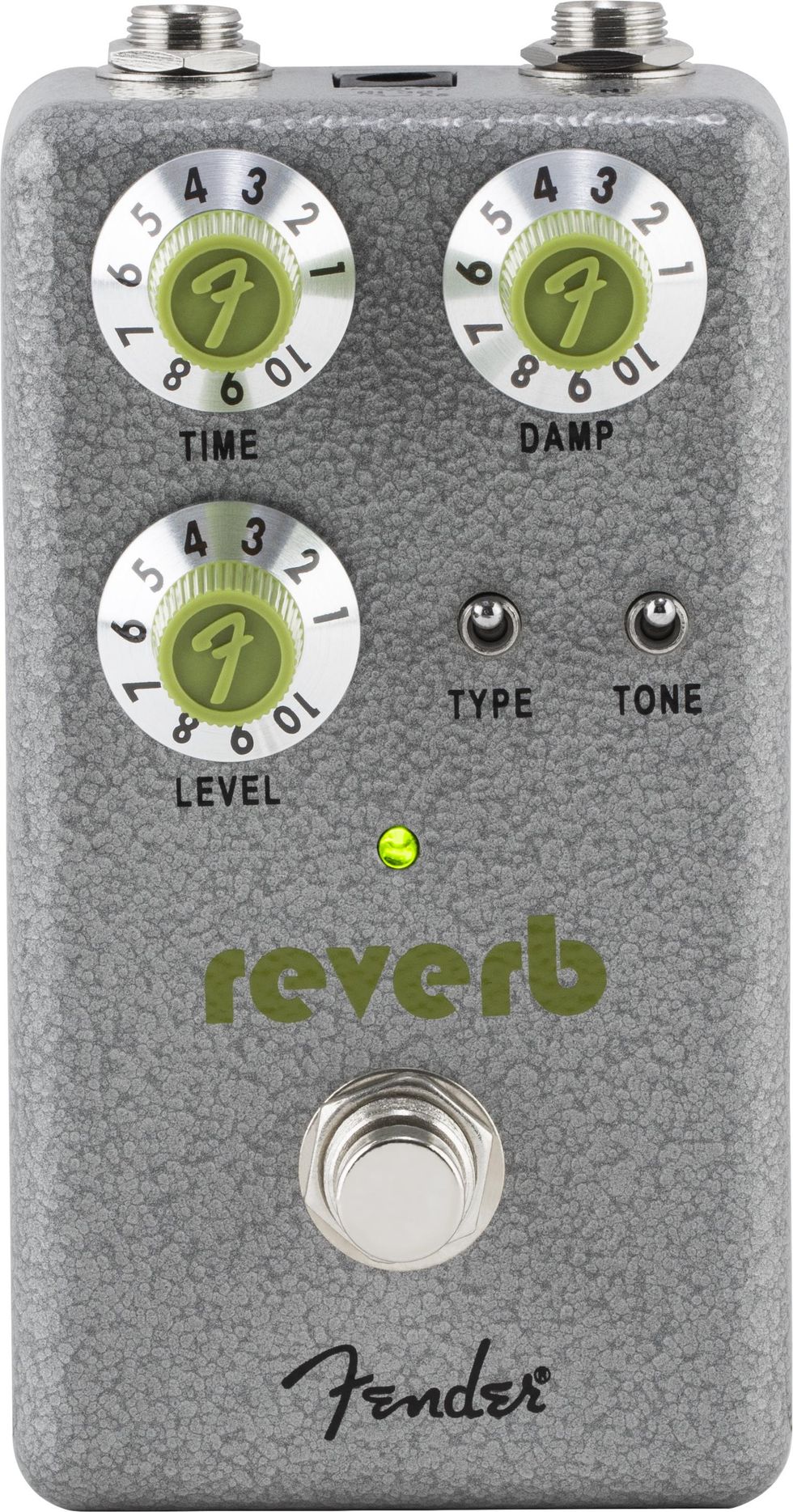
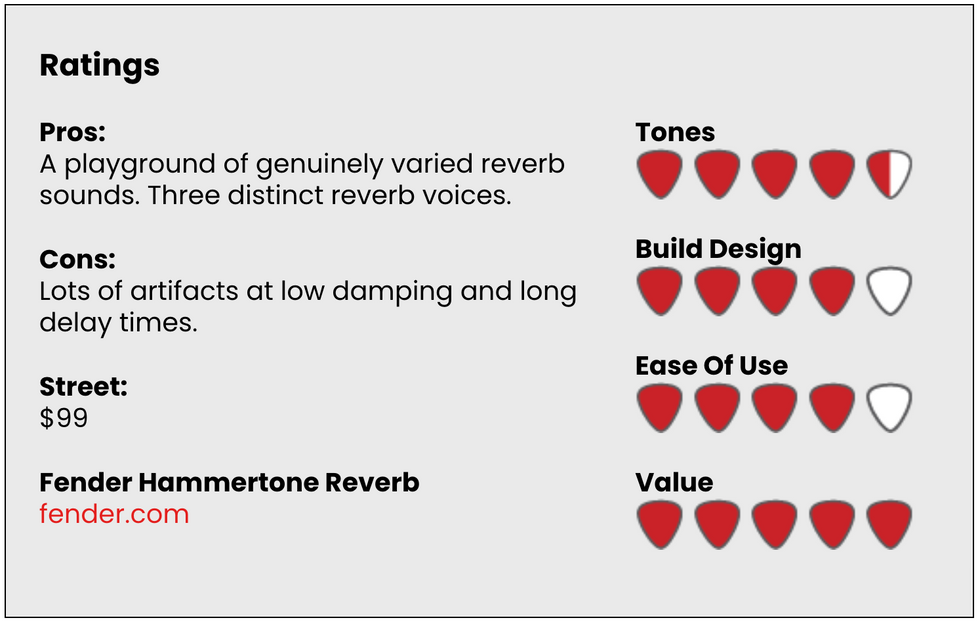
The Hammertone entry in the reverb sweepstakes, strangely, comes with no spring emulation. It hardly matters, though. I was able to dial in convincing spring-like sounds using the pedal’s hall mode. It fared well in an A/B test with a splashy sounding black-panel Vibrolux Reverb. Like a lot of the Hammertone pedals, the Reverb gives you an extensive range to work within, so the hall setting, for instance, can shift from spring-ish sounds to a vacant, massive gymnasium. The room mode is great for fast and subtle reflections and a nice way to add a little body to overdriven tones without creating an overbearing wash. The plate mode is home to loads of treats, too, and, like many pedals in the Hammertone series, has a pleasing, almost-metallic range of overtones that suggest vintage reverbs.
At more radical, high-to-maximum time and level settings you start to hear a lot of cool, odd reflections and overtones.
Each of these voices sound pretty great at mellower or more traditional settings. At more radical, high-to-maximum time and level settings, you start to hear a lot of cool, odd reflections and overtones. At times though, you can also hear digital artifacts and some less-than-flattering high harmonic content in the decay. These qualities are more obvious when the damping control, which controls the length of the reverb tails, is set for a long trail. Exceptionally wet blends, too, can betray digital origins. But there is a bit of hidden treasure among these most extreme sounds: If you max the level and use the most open damping setting, you can almost use the Reverb as a freeze pedal. Additionally, some players may dig these sounds—particularly those that evoke shimmer reverbs without sounding entirely like a shimmer reverb. Even if you rarely explore these corners of the Reverb’s tone collection, the less extreme sounds are plentiful and full of personality, and you can dial in many in-between shades that blend big spaces and cool understated facets.
Hammertone Chorus
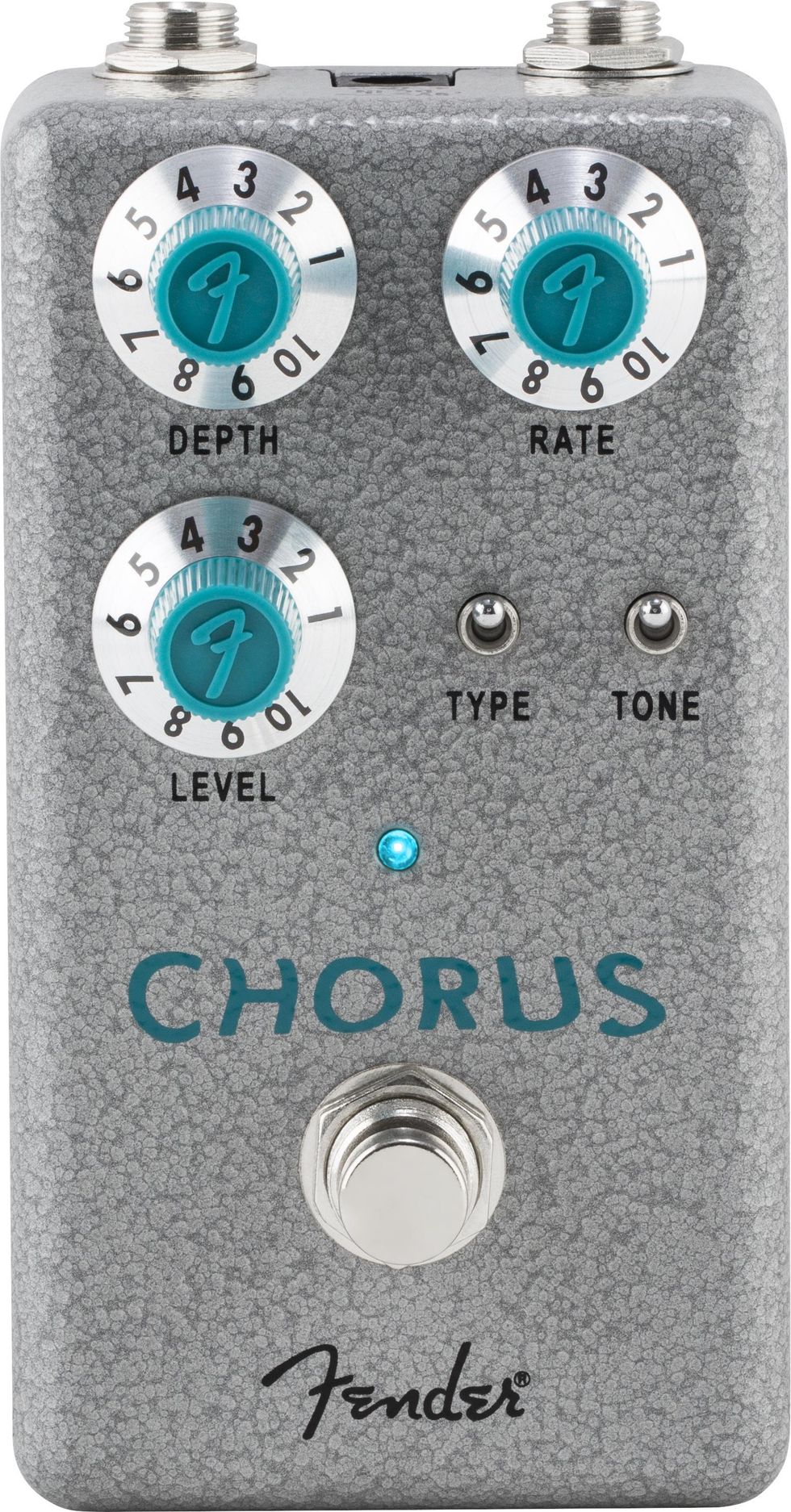
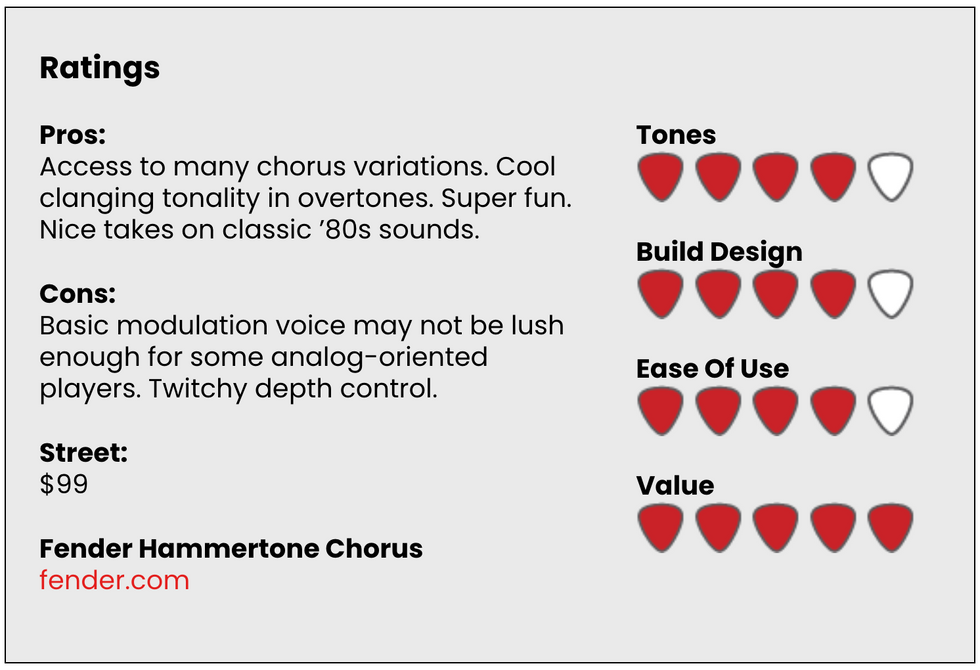
Like most pedals in the Hammertone line, the Chorus generates an impressive palette of sounds for the price. That includes a lot of tones you can safely file under “weird.” It takes a little practice to walk the fine line between radio-friendly chorus tones and odder fare. The Chorus starts to get pretty woozy sounding past 3 on the depth knob. Initially, that can feel constraining. But it’s also a source of surprises once you master the ways in which the Chorus’s controls interact.
The Chorus’s sounds are rooted in the three basic modes. The single-voice mode is focused and airy—leaving ample room for picking dynamics and clear transients, even at high depth settings. The two-voice setting is thicker and sounds more flanger-like at many positions. The two-voice structure produces more unusual phase-cancelling patterns that can give the output a honky midrange focus that cuts as it drifts through waveforms.
The two-voice mode produces very liquid ’80s vintage chorus, including Kurt Cobain/Small Clone-style submarine modulations.
It’s less naturalistic and peakier than the single-voice mode, but it also produces very liquid ’80s vintage chorus, including Kurt Cobain/Small Clone-style submarine modulations when the depth gets to about 4. The 4-voice mode combines four lines with base delay times of 14, 23, 29, and 35 milliseconds. This creates a complex voice that adds subtle motion to prevailingly dry effects mixes or can make wet settings sound like a demented high horn in a rotary speaker.
First impressions of the Chorus’s controls are that they can be twitchy. And the boundary between pleasantly aqueous modulations and downright seasick ones at certain depth settings can be hard to navigate until you get a feel for how the depth and level controls work together. Ultimately, though, the Chorus provides intuitive routes to many modulation ends.
Hammertone Delay
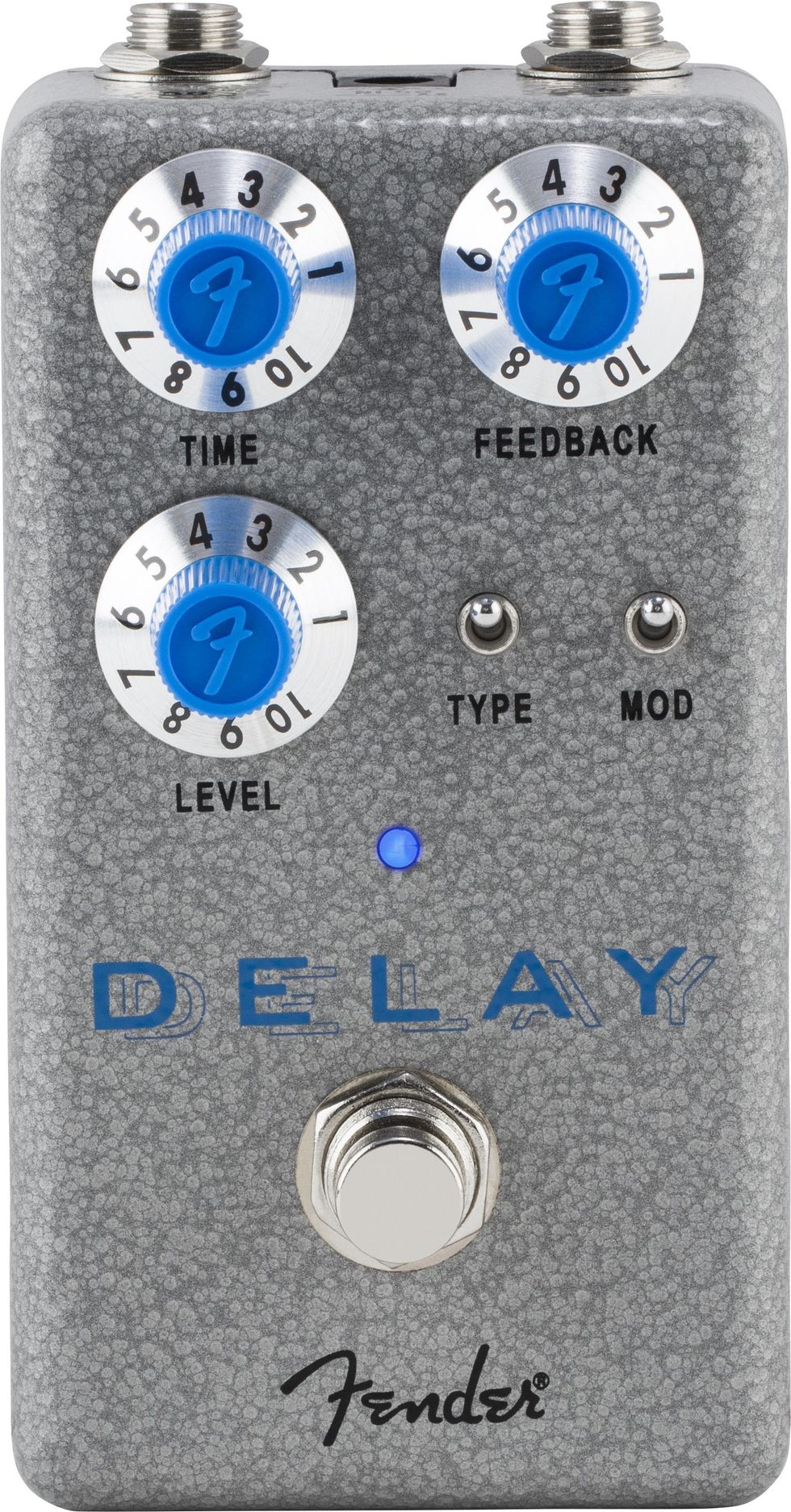
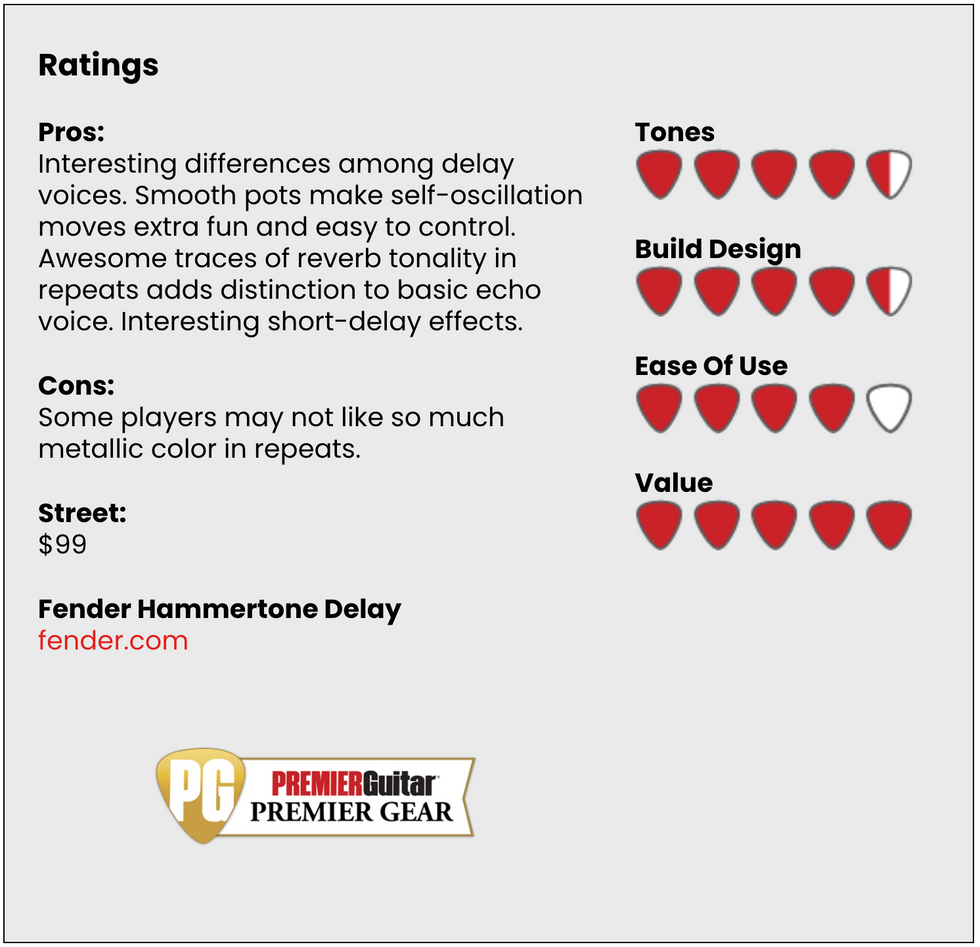
One initial impression of this Fender Delay is that it’s a lot more fun than most inexpensive digital delays. All three of the Delay’s voices have a very present EQ profile with just a hint of almost mechanical, spring-like overtones that feel appropriate for a Fender pedal. The effort Fender put into sourcing smoother, sturdier-feeling potentiometers pays fun dividends here, too. The feedback control, for instance, is really responsive and easy to ride right at the verge of oscillation.
The analog 1 voice generates soft tapering echoes that blend into the background as they decay—a treasured facet of genuine bucket brigade delays. It can be genuinely subtle, even at advanced feedback, level, and time settings. And at equivalent feedback levels, analog 1 will yield many fewer perceptible repeats than the middle-position digital voice. Analog 1’s washy, less distinct repeats shine at certain extremes as well. Long feedback settings, delay-heavy mixes, and super-short delay times yield a weird blend of metallic spring reverb and Abbey Road automatic double-tracking tones. The more subtle repeats also mean you can crank the feedback without making a total mess.
Clear repeats also expand the potential for punchier beat-centric and repetitive patterns and riffs.
Things are different over on the digital voice. In this domain, repeats ring with clarity, and the ghosts of bum notes will haunt you if you’re not careful. But the clear repeats also expand the potential for punchier beat-centric and repetitive patterns and riffs. Analog 2 is my favorite voice. Its mid-forward repeats excite a more prominent, shimmering set of harmonics. It’s a great environment for enjoying the mix of those extra overtones and a dose of extra motion from the pedal’s modulation section.
The modulation can be dialed up to amazingly queasy levels of intensity at high depth and repeat settings. In general, though, I like the modulation depth at more modest levels. And the Delay sounds nice enough to require little in the way of modulation dressing. That said, I strongly suggest this mode with the Hammertone Chorus. It’s a yummy combo.
There are more immaculate digital delays and more authentic digital takes on bucket brigade echo. But to me, the Delay’s quirks are big plusses. That they so interestingly color the pedal’s broad range of personalities make it a true bargain.
Hammertone Flanger

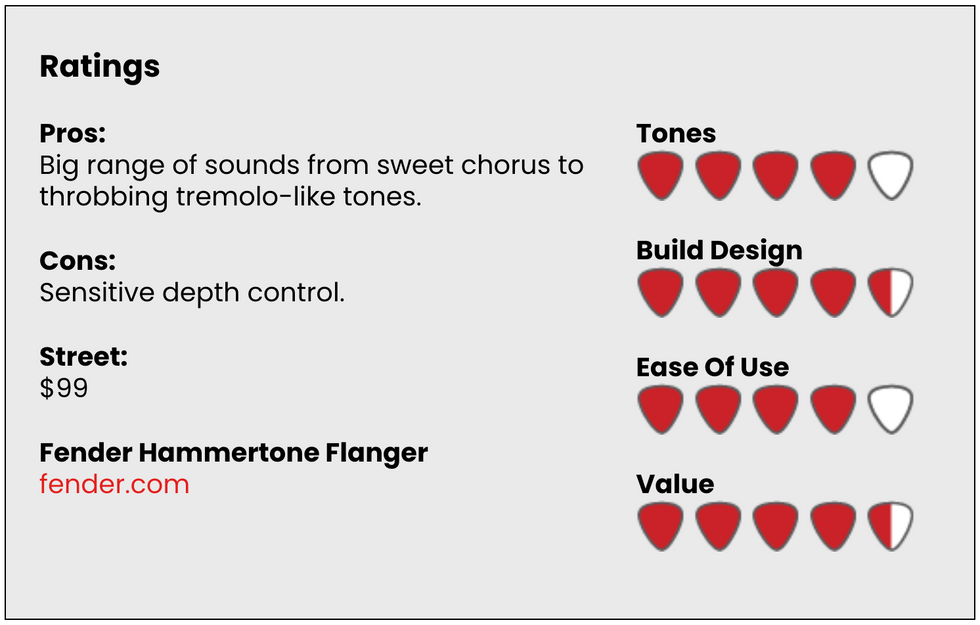
The Hammertone Flanger is a reliably flexible pedal. It generates great chorus tones (some of which I preferred to roughly equivalent sounds from the Hammertone Chorus), and slow whoosing sweeps can be the antidote to the sick-of-my-phaser blues. But great core flanger tones abound, too, including mind-warp, hit-of-nitrous jet flange, and gentler, less tone-mangling sounds that pulse with a nice, almost tremolo-like modulation.
Coaxing the tones you want from the Flanger won’t necessarily be automatic. The basic voice is, like many of the Hammertone pedals, colored by a high-mid focus that’s evocative of hard-surface reverb reflections. On the Flanger, that voice can read as harsh in places. But the Flanger’s easily mastered controls make it simple to find softer landings. The two mini toggles are key if you generate a sound that’s a bit too intense. The type switch, which here controls feedback polarity, can recast a super-peaky setting with a flick.
The basic voice is colored by a high-mid focus that’s evocative of hard-surface reverb reflections.
The resonance switch is an even more valuable escape hatch—or portal to weirdness. It takes the place of a resonance or feedback knob that you’d see on many flangers. Generally, replacing a knob with a switch that moves between presets means diminished flexibility. But the Flanger’s voices each inhabit a sweet spot that you can modify with the depth and manual controls, the latter of which governs the delay time between the split signals that make up the flanger tone. If there is a downside to abundance of control, it’s that it can be a minor chore to dial in precisely the sound you’re looking for. As with the Chorus, the depth control can move from just-right to wild with a minor accidental nudge. Thankfully, there aren’t many bad sounds to make such an accident too jarring.
Hammertone Overdrive
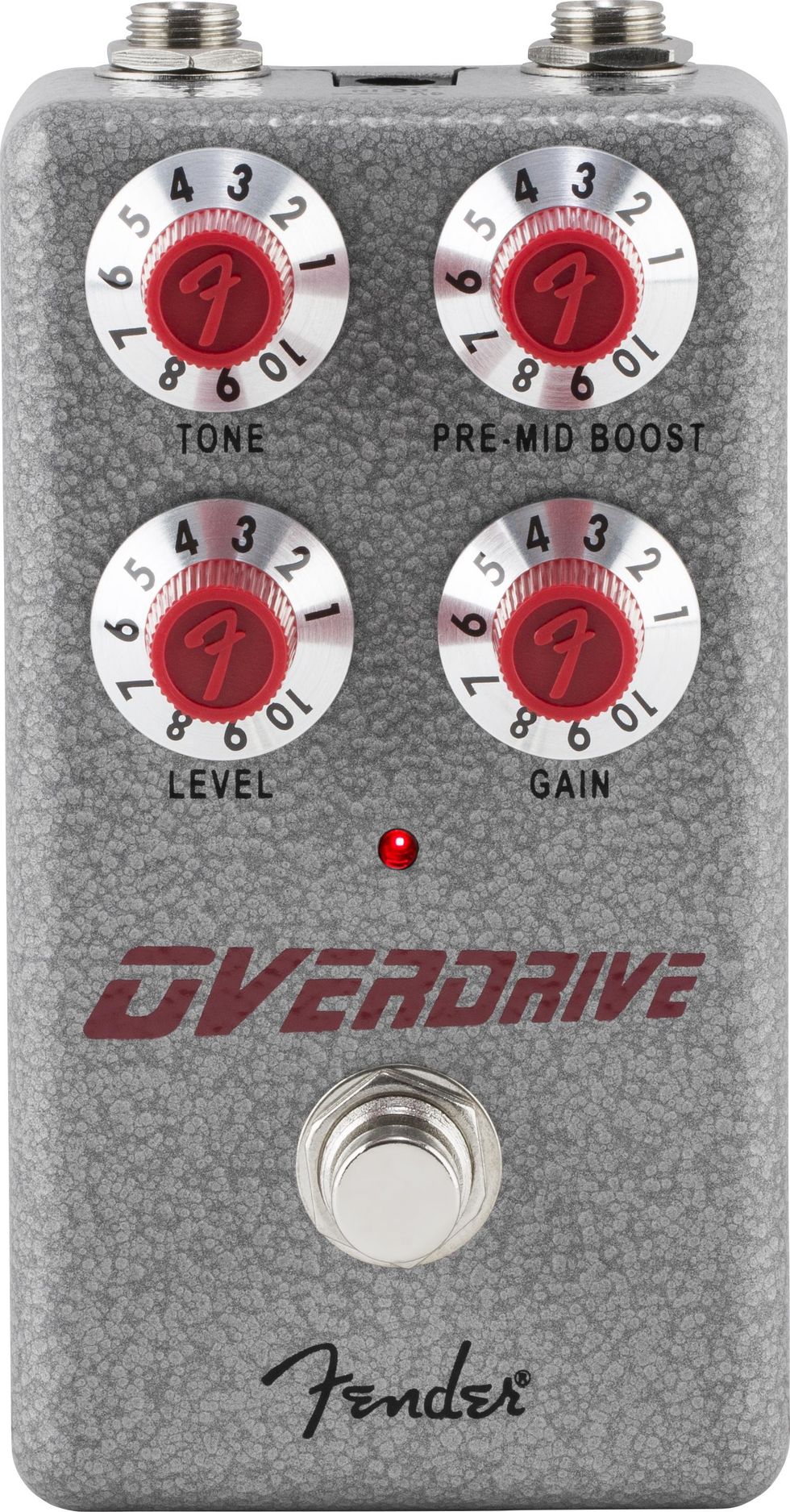
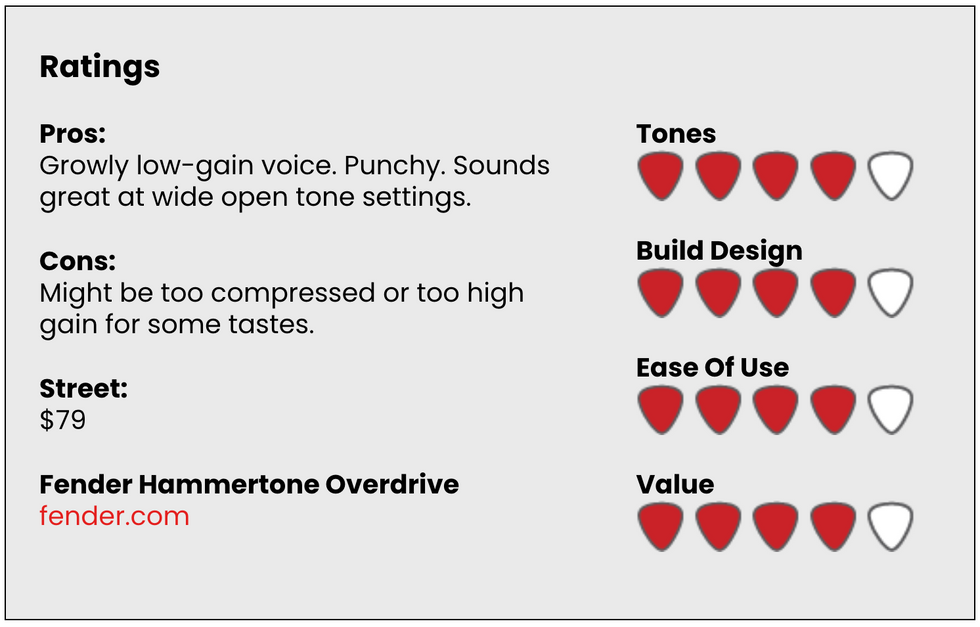
If you line up the Hammertone Overdrive alongside other popular overdrives (in my case, a TS9, an inexpensive klone, and a Boss SD-1), you hear a pedal much more aligned with the TS/SD-1 camp—tight, mid-forward, and punchy. But it is still a very different pedal in terms of feel and range.
The Overdrive is most easily distinguished and differentiated by its hotter gain profile. The distortion sounds you hear at gain settings of 1 to 3 on the Overdrive are roughly equivalent to the distortion you get north of noon on the TS, Boss, and klone. There’s also the sense of a touch more compression at equivalent settings. That recipe makes the Overdrive a sort of inhabitant of the borderlands between overdrive and distortion.
At its lowest gain setting the Overdrive still growls and feels ready to pounce.
If you’re not inclined to use your guitar volume control much, the Overdrive doesn’t have a ton of cleanish tones to offer. At its lowest gain setting it still growls and feels ready to pounce. And even significant guitar volume attenuation still leaves discernible grit. That may sound constraining at first, but if you use maximum output and tone, minimum gain, and a dynamic touch with your fingers and guitar volume, you can span a huge range of sounds from explosive to mellow and hazy. The Overdrive’s capacity for dynamism may not always be obvious, but it’s there if you open the pedal up and let your fingers do the expressive work.
Though the Overdrive feels pretty-mid forward to me, there is a pre-mid boost. There’s a lot of utility in this control. It can help the Overdrive span more of the distance between a TS and Klon, and it can make the transition between humbuckers and single-coils easier to manage. In general, though, I found that the Overdrive sounded airiest and best able to breathe with the tone wide open and the mids scooped. Unleash the gain in this kind of setup and the Overdrive sounds pretty beastly.











![Rig Rundown: AFI [2025]](https://www.premierguitar.com/media-library/youtube.jpg?id=62064741&width=1245&height=700&quality=70&coordinates=0%2C0%2C0%2C0)




